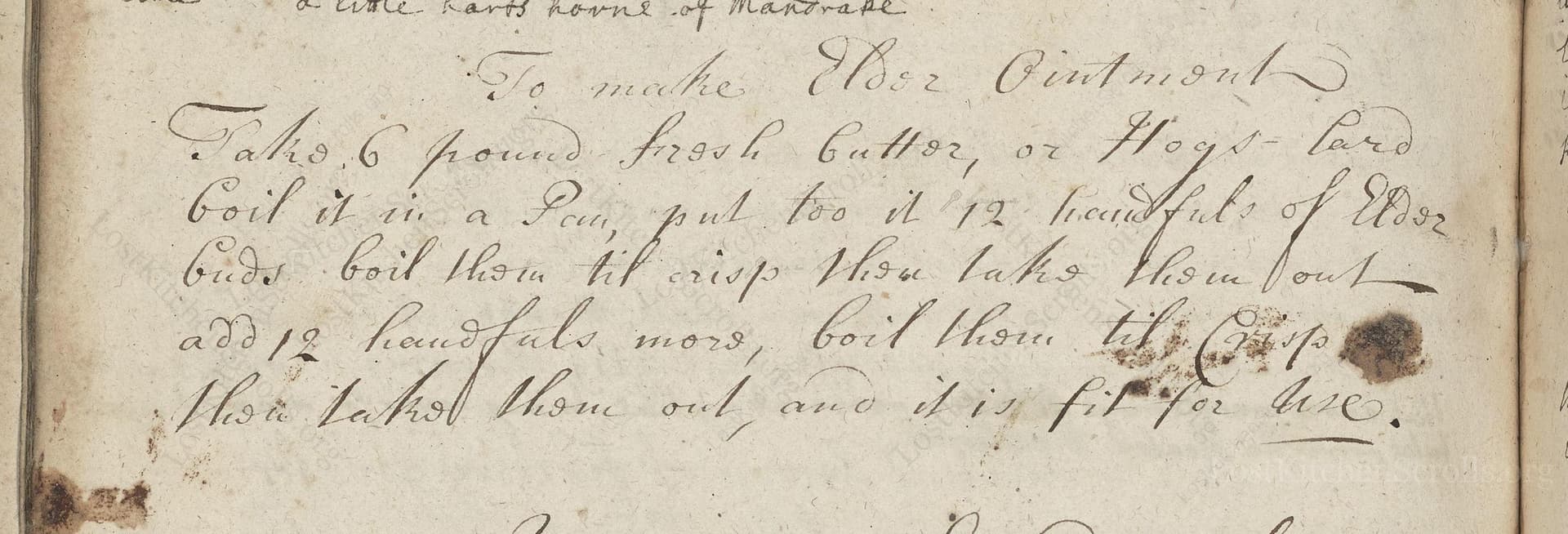To Make Elder Ointment
From the treasured pages of Cookbook of Jane Dawson
Written by Jane Dawson

To Make Elder Ointment
"Take 6 pound fresh butterr, or Hogs lard, boil it in a Pan, put to it 12 handsfule of Elder buds, boil them till crisp, Then take them out add 12 handsfule more, boil them till crisp Then Take them out, and it is fit for Use."
Note on the Original Text
The recipe uses a direct, imperative style, reflecting the oral transmission of culinary knowledge at the time—'take', 'boil', 'put'. Quantities are given in 'handsfule', a flexible unit based on the cook's own hands, which required a degree of experiential judgment. Spellings such as 'hogs lard' and 'handsfule' are simply the norms of early modern English and not errors. The directions prioritize the order of operations and key visual cues like the buds being 'till crisp', rather than precise timing or temperatures.

Title
Cookbook of Jane Dawson (1690)
You can also click the book image above to peruse the original tome
Writer
Jane Dawson
Era
1690
Publisher
Unknown
Background
A delightful glimpse into late 17th-century English kitchens, Jane Dawson's recipe collection is a flavorful tapestry of sweet delicacies and savory dishes, revealing the tastes and ingenuity of bygone home cooks.
Kindly made available by
Folger Shakespeare Library
This recipe comes from the late 17th century, attributed to Jane Dawson, and reflects the domestic medicinal skills of women during this period. Elder was highly prized for its healing properties, particularly for skin ailments, swelling, or minor cuts. Making ointments at home was commonplace, with recipes passed down through families and handwritten into recipe books, as seen in this manuscript. The use of butter or lard as a base exemplifies the reliance on simple, farm-based ingredients and the practical ingenuity of early modern English households.

The original preparer would have used a large iron or copper cauldron or pan for boiling the fat, likely over an open hearth or a controlled fire. Ladles or wooden spoons were used to stir and remove the fragrant, crisped elder buds. The ointment would have been strained and poured hot into earthenware jars or small wooden boxes to cool and set. Linen cloths might be used for straining if a very smooth product was desired.
Prep Time
20 mins
Cook Time
40 mins
Servings
24
We've done our best to adapt this historical recipe for modern kitchens, but some details may still need refinement. We warmly welcome feedback from fellow cooks and culinary historians — your insights support the entire community!
Ingredients
- 6 pounds fresh unsalted butter or high-quality pork lard (as available)
- 3 pounds 2 ounces fresh elder buds (as a substitute: 10.5–14 ounces dried elderflower)
- No salt or additional water
Instructions
- To craft this elder ointment in a modern kitchen, start by melting 6 pounds of fresh unsalted butter or pure lard in a large, heavy-bottomed saucepan over low heat.
- Once fully melted, add approximately 12 generous handfuls (about 1 pound 9 ounces) of elder buds; if elder buds are not in season, you may substitute with dried elderflower, though the effect will differ slightly.
- Simmer the buds in the hot fat, stirring occasionally, until they become crisp but not burnt—this will infuse the fat with their essence.
- Remove the spent buds with a slotted spoon, then add another 12 handfuls (another 1 pound 9 ounces) of fresh elder buds, repeating the process.
- Once crisp, remove these as well.
- The infused fat, now richly scented with elder, is ready to strain and store in a clean jar or tin for later use as an ointment.
Estimated Calories
110 per serving
Cooking Estimates
You will need a bit of time to prepare the elder buds and melt the fat. Infusing the elder buds in two batches takes some time on the stove, and you'll also spend a little time straining the finished ointment. The calories are based on serving the ointment in small portions, as you would use for skincare.
As noted above, we have made our best effort to translate and adapt this historical recipe for modern kitchens, taking into account ingredients nowadays, cooking techniques, measurements, and so on. However, historical recipes often contain assumptions that require interpretation.
We'd love for anyone to help improve these adaptations. Community contributions are highly welcome. If you have suggestions, corrections, or cooking tips based on your experience with this recipe, please share them below.
Join the Discussion
Rate This Recipe
Dietary Preference
Culinary Technique
Occasions

Den Bockfisch In Einer Fleisch Suppen Zu Kochen
This recipe hails from a German manuscript cookbook compiled in 1696, a time whe...

Die Grieß Nudlen Zumachen
This recipe comes from a rather mysterious manuscript cookbook, penned anonymous...

Ein Boudain
This recipe comes from an anonymous German-language manuscript cookbook from 169...

Ein Gesaltzen Citroni
This recipe, dating from 1696, comes from an extensive anonymous German cookbook...
Browse our complete collection of time-honored recipes



